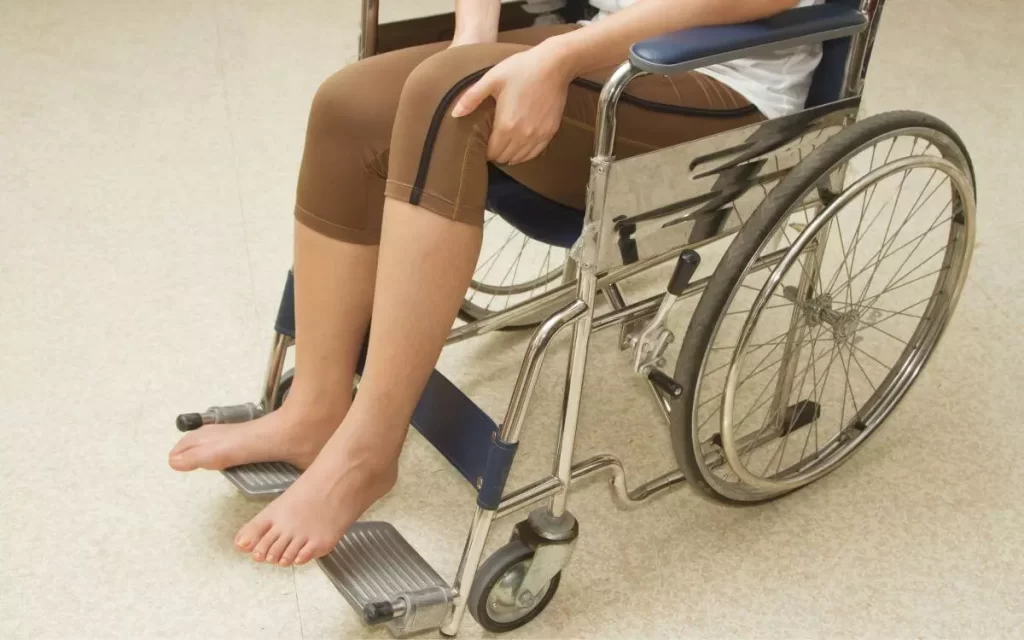Why do people who can walk use wheelchairs?
There are many chronically ill people who can walk. Wheelchair users who can walk may suffer from conditions like endometriosis and fibromyalgia. My wife is one of them. She also experiences extreme chronic fatigue. So, do people who can walk use wheelchairs?
Yes, they do.
People who can walk use wheelchairs because they want to maintain independence, however, it also allows them to conserve energy, reduce flares and pain, increase mobility while staying active but avoiding fall-related injuries, and travel further distances to improve their quality of life.
To expand on it a little bit more, I’ve included a list of wheelchair users who can walk and the reasons why they use a wheelchair instead of walking.
Let’s begin by exploring what kinds of chronic conditions make people consider using a wheelchair…
Which wheelchair users can walk?
Some of the most known kinds of mobility impairments are amputations, paralysis, spinal injuries, Cerebral Palsy, Multiple Sclerosis, and Muscular Dystrophy. But there are also people who at first glance seem okay, who have conditions like Endometriosis, Lupus, Fibromyalgia, Chronic Fatigue Syndrome, Lyme Disease, and even mental illness.
Let’s say a person with endometriosis spends an entire day walking around. By the end of the day, they would be in so much pain that they would be unable to stand or walk. The next day, they might be able to walk again, but the pain would still be there.
This is exactly what my wife is like, her advanced type, stage IV deep infiltrating endometriosis is at times very disabling. But she also has fibromyalgia.
When it comes to fibromyalgia, this disorder can definitely put the person in a wheelchair, it can even make that person bedridden.
People with fibromyalgia often experience pain all over their bodies, as well as fatigue and sleep problems. Brain fog is also a common symptom, which can make it hard to think clearly or remember things.
All of these symptoms can make it hard for someone to function on a day-to-day basis. And for many people, using a wheelchair is the best way to manage their fibromyalgia.
A wheelchair gives them the independence to choose when they want to walk and when they need to rest. It also eliminates the need to find a place to sit down every time the pain gets too bad. I personally met two women with fibromyalgia who use wheelchairs.
In terms of a chronic condition like Lupus, this is an autoimmune disease that can attack any part of the body. The most common symptom is fatigue, but Lupus can also cause joint pain, rashes, and kidney problems.
There is no cure for Lupus, but there are treatments that can help manage the symptoms. For some people, using a wheelchair is the best way to manage this condition.
Wheelchairs provide independence and allow people with Lupus to control when they want to walk and when they need to rest. They also make it easier to stay active, which is important for managing Lupus.
Lyme Disease can be another reason why people who can walk use wheelchairs. Lyme Disease is a bacterial infection that is transmitted by ticks. The most common symptom is a rash, but Lyme Disease can also cause joint pain, fatigue, and neurological problems.
As with Lupus, there is no cure for Lyme Disease.
With conditions such as fibromyalgia, Chronic Fatigue Syndrome often goes hand in hand. In fact, many doctors believe that Chronic Fatigue Syndrome is just a more severe form of fibromyalgia.
Chronic Fatigue Syndrome is a condition that causes extreme fatigue, as well as other symptoms like sleep problems, joint pain, and headaches.
There is no cure for CFS, people are often bedbound, and many use wheelchairs as a way to get around.
Some wheelchair users who can walk do so because they have a mental illness. Mental illness can be just as disabling as a physical condition.
Mental illnesses like anxiety and depression can make it hard for someone to function on a day-to-day basis. Many people with mental illness use wheelchairs as a way to get around and manage their condition.
My wife has it all – endometriosis, fibromyalgia, chronic fatigue (although not CFS), anxiety, panic attacks, depression, and even OCD.
Despite all the above, my wife is still a fairly independent woman, but this makes it difficult for others to understand, let alone believe that she often struggles to walk. I remember one month, when for 3 weeks straight my M struggled to get out of bed only to have a shower and get back to sleep.
This is why invisible conditions like endometriosis and fibromyalgia make it difficult for all those chronically ill people who can walk. They often look “fine” on the outside. People just don’t get it.
If you want more in-depth information about how to support your partner with her chronic conditions and how to cope with the new normal in your relationship, I wrote a “Supporting a Chronically Ill Partner” e-Book.
You can get the 1st Chapter of the e-Book for FREE, and if you like it, you’ll get a Whopping 33% Discount on the Whole Book, plus discounts on other helpful tools. You have nothing to lose but a lot to gain!
The first chapter alone contains a lot of information for both of you about acknowledging the struggles, including:
- A word to your partner.
- A word to you.
- Stepping on eggshells.
- Understanding her needs.
- How to acknowledge having a chronically ill partner?
- Acknowledging can be hard.
- 15 tips on how to do it!
Get the 1st Chapter FREE!
Chronic Illness for Partners

Why do people who can walk use wheelchairs?
The main reasons wheelchair users who can walk do so are:
- To conserve energy.
- To manage pain.
- To reduce flares.
- To increase mobility.
- To maintain independence.
- To reduce flares of pain.
Wheelchair users who can walk often do so to conserve energy. This is because walking takes a lot of energy and can be very painful.
Wheelchair users who can walk may also do so to reduce flares. This is because walking can trigger flares, or episodes of pain, in conditions like endometriosis and fibromyalgia.
Finally, wheelchair users who can walk may do so to increase mobility. This is because wheelchair use can help people with chronic illnesses travel further and faster than they could if they were walking.
So, those are the main reasons why people who can walk use wheelchairs. Now, let’s take a closer look at each of these reasons.
The first reason wheelchair users who can walk do so is to conserve energy. Walking takes a lot of energy and can be very painful. For people with chronic illnesses, this can be a huge problem.
Wheelchair users who can walk often find that using a wheelchair helps them conserve energy and stay pain-free. Pain and loss of energy are two of the main symptoms of conditions like fibromyalgia, Chronic Fatigue Syndrome, and endometriosis.
The second reason wheelchair users who can walk do so is to reduce flares.
Walking can trigger flares, or episodes of pain, in conditions like endometriosis and fibromyalgia. This can be a big problem for people with these conditions. wheelchair users who can walk often find that using a wheelchair helps them reduce flares and manage their pain better.
The third reason wheelchair users who can walk do so is to increase mobility.
Wheelchair use can help people with chronic illnesses travel further and faster than they could if they were walking. This is a huge benefit for people because wheelchair users who can walk often find that using a wheelchair helps them increase their mobility and travel more easily.
So, those are the main reasons why people who can walk use wheelchairs.

The invisible becomes visible!
The wheelchair is one of the most visible symbols of disability. When people see someone in a wheelchair, they automatically assume that the person is unable to walk. However, this is not always the case. There are many wheelchair users who can walk, but choose to use a wheelchair for a variety of reasons.
The main reasons why wheelchair users who can walk do so are: to conserve energy, reduce flares, increase mobility, and maintain independence.
People who can walk but use wheelchairs often face judgment from others. People assume that they are lazy or that they are trying to get attention. These assumptions are usually based on ignorance.
The truth is that people who can walk but use wheelchairs do so for very practical reasons.
If you see someone in a wheelchair who can walk, don’t assume that they are lazy or attention-seeking. Instead, try to understand why they use a wheelchair. Chances are, they have a good reason for doing so.
Conclusion.
Wheelchair use can help people with chronic illnesses conserve energy, reduce flares, and increase their mobility. If you or someone you know suffers from a chronic illness, consider using a wheelchair to help manage the condition.
There are a few different reasons why people who can walk mightily choose to use a wheelchair.
For some, it may be a matter of convenience or preference, but wheelchairs can be easier to maneuver than walking, and they may allow chronically ill people to travel further distances without getting tired.
For others, the choice to use a wheelchair may be medically necessary. Some chronic illnesses can cause fatigue or pain that makes walking difficult or impossible. In these cases, using a wheelchair can help people stay mobile and maintain their independence.
Whatever the reason, wheelchair use is a personal choice. Some wheelchair users may only use their wheelchair some of the time, while others may rely on it for all of their mobility needs. There is no right or wrong way to use a wheelchair – ultimately, it’s up to you or your partner to decide what works best.
I hope you found it helpful. If you did, do share this article with others. And remember, if you have a story of your own, do tell. I always look forward to hearing from the partners of chronically ill people. I’m looking forward to hearing your story.
And if you have some tips or advice, I am always happy to meet you in the comments section below.
Thank you!


About Me
Hi, I’m Lucjan! The reason why I decided to create this blog was my beautiful wife, who experienced a lot of pain in life, but also the lack of information about endometriosis and fibromyalgia for men…
